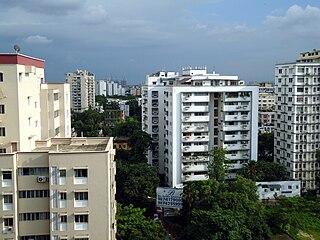
Dum Dum is a city and a municipality of North 24 Parganas district in the Indian state of West Bengal. It is a part of Kolkata urban area and also a part of the area covered by Kolkata Metropolitan Development Authority (KMDA).

Barasat is a city and a municipality of North 24 Parganas district in the Indian state of West Bengal. It is the headquarters of Barasat Sadar subdivision. It is a part of the area covered by Kolkata Metropolitan Development Authority (KMDA). Located in the Ganges delta, Barasat is a regional transportation hub as a rail and road junction. National Highway 12, NH 112, Taki Road and Barrackpore-Barasat Road are the main connectivity links to the city.

Ballygunge is a locality of South Kolkata, in Kolkata district, West Bengal, India.

Halisahar is a city and a municipality of North 24 Parganas district in the Indian state of West Bengal. It is a part of the area covered by Kolkata Metropolitan Development Authority (KMDA).

Panihati is a city and a municipality of North 24 Parganas district in the Indian state of West Bengal. It is close to Kolkata and also a part of the area covered by Kolkata Metropolitan Development Authority (KMDA).

Kamarhati is a city and a municipality of North 24 Parganas district in the Indian state of West Bengal. It is close to Kolkata and also a part of the area covered by Kolkata Metropolitan Development Authority (KMDA).

Bidhannagar is a city and a municipal corporation of the North 24 Parganas in the Indian state of West Bengal. It is in Greater Kolkata region and also a part of the area covered by the Kolkata Metropolitan Development Authority (KMDA). It consists of sub areas like Rajarhat and Salt lake, which were planned and developed between 1958 and 1965 to accommodate the burgeoning population of Kolkata.

Rabindra Sarobar is an artificial lake in South Kolkata in the Indian state of West Bengal. The name also refers to the area surrounding the lake. It is flanked by Southern Avenue to the North, Shyamaprasad Mukherjee Road to the West, Dhakuria to the East and the Kolkata Suburban Railway tracks to the south.

Chittaranjan Avenue, more commonly C.R. Avenue, a principal north-south thoroughfare in Central-North Kolkata. It starts from Beadon Street crossing in the north and ends at Chowringhee Road-Bentinck Street Junction (Esplanade) in the south. The road is renamed after Deshbandhu Chittaranjan Das, a nationalist politician and freedom-fighter of India. North of Beadon Street crossing, Chittaranjan Avenue becomes Jatindra Mohan Avenue.

Kolkata Municipal Corporation is the local government of the Indian city of Kolkata, the state capital of West Bengal. This civic administrative body administers an area of 206.08 square kilometres (79.57 sq mi). Its motto, Purosri Bibardhan, is inscribed on its emblem in Bengali script.

Kolkata Metropolitan Development Authority (KMDA) is the statutory planning and development authority for the Kolkata Metropolitan Area (KMA) in the state of West Bengal, India. The organisation used to be known as Calcutta Metropolitan Development Authority (CMDA) and retains the previous logo. KMDA is functioning under the administrative control of Department of Urban Development and Municipal Affairs of Government of West Bengal.
Kolkata Metropolitan Area, also known as Greater Kolkata, is the urban agglomeration of the city of Kolkata in the Indian state of West Bengal. It is the third most populous metropolitan area in India after Delhi and Mumbai. The area is administered by the Kolkata Metropolitan Development Authority (KMDA). The area covers four municipal corporations along with 37 municipalities. Kolkata metropolitan district was legally defined in the schedule of the Calcutta Metropolitan Planning Area Control Act, 1965, and, after repeal of that Act, redefined as Kolkata metropolitan area in the first schedule of West Bengal Town and Country Act, 1979.

Kanchrapara is a city and a municipality of North 24 Parganas district in the Indian state of West Bengal. It is a part of the area covered by Kolkata Metropolitan Development Authority (KMDA).

North Dum Dum is a city and a municipality of North 24 Parganas district in the Indian state of West Bengal. It is close to Kolkata and also a part of the area covered by Kolkata Metropolitan Development Authority (KMDA).

South Dum Dum is a city and a municipality of North 24 Parganas district in the Indian state of West Bengal. It is close to Kolkata and also a part of the area covered by Kolkata Metropolitan Development Authority (KMDA).

Rashbehari Avenue is one of the most prestigious and important east–west avenues of Kolkata, India. A major portion of this road is often commonly referred to as Gariahat, the prime shopping and aristocratic residential neighbourhood of south Kolkata. Rashbehari Avenue falls in the posh residential neighbourhood of Ballygunge. The road is named after Sir Rash Behari Ghosh who was an Indian politician, lawyer, social worker and philanthropist.

Hawkers in Kolkata numbering 275,000 generated business worth ₹ 87.72 billion in 2005. In Kolkata, formerly known as Calcutta, in the Indian state of West Bengal, almost 80 per cent of the pavements are encroached by hawkers and illegal settlers. In many countries, hawkers use pavements or other public places to retail their goods or services but in Kolkata the magnitude has drawn special attention of administrators and law courts.

The civic administration of Kolkata is executed by several government agencies, and consists of overlapping structural divisions. Kolkata's administrative agencies have areas of jurisdiction that do not coincide.

Beliaghata, also known as Beleghata, is a neighbourhood of Central Kolkata, in Kolkata district, West Bengal, India.

Lake Town is a locality in South Dumdum Municipality of North 24 Parganas district in the Indian state of West Bengal. It is close to Kolkata and also a part of the area covered by Kolkata Metropolitan Development Authority (KMDA).



















